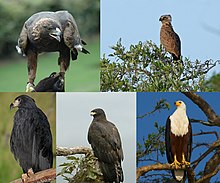Eagle is a general term for many large birds of prey. Over 60 species have been described, and they live in many parts of the world. Most species of eagle are found in Eurasia and in Africa.[1]
| Eagle | |
|---|---|

| |
| From left to right: golden eagle (Aquila chrysaetos), brown snake eagle (Circaetus cinereus), solitary eagle (Buteogallus solitarius), black eagle (Ictinaetus malaiensis) and African fish eagle (Haliaeetus vocifer). | |
| Scientific classification | |
| Domain: | Eukaryota |
| Kingdom: | Animalia |
| Phylum: | Chordata |
| Class: | Aves |
| Order: | Accipitriformes |
| Family: | Accipitridae |
Eagles are not a natural monophyletic group. The name describes a bird of prey big enough to hunt larger vertebrates. Eagles hunt during the day and have very good eyesight. Eagles are generally put in the family Accipitridae. They belong to several groups of genera, some of which are closely related.
The largest eagle that has ever lived is Haast's eagle. It is the only eagle in the world ever to have been top predator of its ecosystem. Though it is now extinct, it lived in New Zealand. Before man got there, it preyed on moas.
Eagles are carnivores. This means that they eat meat from other animals. Eagles are birds of prey, and so are vultures, falcons and owls. Eagles use their strong talons to catch and grab their food, and they use their sharp beaks to help them tear into the meat of their prey.
References
change- ↑ del Hoyo J; Elliot A. & Sargatal J. (editors). 1994. Handbook of the Birds of the World Volume 2: New World Vultures to Guineafowl. Lynx Editions. ISBN 84-87334-15-6